-
Categories
-
Pharmaceutical Intermediates
-
Active Pharmaceutical Ingredients
-
Food Additives
- Industrial Coatings
- Agrochemicals
- Dyes and Pigments
- Surfactant
- Flavors and Fragrances
- Chemical Reagents
- Catalyst and Auxiliary
- Natural Products
- Inorganic Chemistry
-
Organic Chemistry
-
Biochemical Engineering
- Analytical Chemistry
-
Cosmetic Ingredient
- Water Treatment Chemical
-
Pharmaceutical Intermediates
Promotion
ECHEMI Mall
Wholesale
Weekly Price
Exhibition
News
-
Trade Service
Responsible editor | Xi
The treatment of brain tumors has always been a worldwide problem, and the current obstacles mainly come from two aspects: 1.
Restrict the blood-tumor barrier of most drugs from entering brain tissue; 2.
Resting tumor cells
resistant to conventional chemotherapy.
Brain tumor cells grow in a physical microenvironment
with different mechanical forces and tissue hardness.
The mechanically sensitive ion channel Piezo senses the physical microenvironment and converts mechanical signals into an increase in intracellular calcium concentration in the form of calcium influx, which initiates cell signaling
.
Whether it can target the blood-tumor barrier and resting tumor cells to effectively treat brain tumors is a hot spot and difficulty in biomedical research
.
On November 1, 2022, the team of Huang Xi of the University of Toronto published a long article in the journal Neuron entitled Mechanosensitive brain tumor cells construct blood-tumor barrier to mask chemosensitivity research papers
.
The study found that in medulloblastoma, the projections of Sox2+ tumor cells wrap around capillaries
.
This phenomenon relies on the mechanically sensitive ion channel Piezo2
.
At the same time, the gradient of tissue hardness increases
as the distance from the capillaries decreases.
Sox2+ tumor cells sense matrix stiffness through Piezo2 to maintain intracellular local calcium concentration, enhance actin contraction and cell adhesion, thereby promoting the growth of cell protrusions and localizing β-Catenin on the cell surface
.
Knocking out Piezo2 reversed the WNT/β-Catenin signaling state between Sox2+ tumor cells and vascular endothelial cells, and activated resting Sox2+ tumor cells while destroying the blood-tumor barrier, greatly enhancing the response
of medulloblastoma to chemotherapy.
Using a mouse model of medulloblastoma, the researchers found that there is a new blood-tumor barrier structure
composed of Sox2+ tumor cells in tumor tissue.
In this structure, the endfeet emitted by Sox2+ tumor cells wrap capillaries firmly like tentacles, forming a blood-tumor barrier similar to the normal blood-brain barrier, limiting the exchange
of substances between blood and brain tumor tissue.
At the same time, the coverage of capillaries by Sox2+ tumor cells is time-dependent
.
With the development of tumor-carrying mice, the coverage of Sox2+ tumor cells gradually increased, and the degree of obstruction to blood substances also gradually increased
.
The researchers also found that Sox2+ tumor cells express the mechanical force-sensitive ion channel Piezo2
.
Using cell stretching devices, calcium imaging, and patch-clamp techniques, the researchers found that Piezo2-knocked Sox2+ tumor cells lost most of their ability to respond to
external mechanical stimuli.
These results suggest that Piezo2 is the main receptor for Sox2+ tumor cells in response to external mechanical stimuli
.
After specifically knocking out Piezo2 in medulloblastoma, the researchers were surprised to find that Piezo2 knockout 1 reduced the length of Sox2+ tumor cell protrusions; 2.
Reduce the thickness of the vascular basement membrane; 3.
Reduce the coverage of perivascular cells; 4.
Inhibit the tight connection of blood vessels and increase the space between endothelial cells; 5.
Cause the phenotype of porous vascular endothelial cells to appear ectopic in central nervous system tumors; 6.
It greatly increases the penetration
of blood substances in brain tissues around capillaries.
These results suggest that knockout tumor-expressed Piezo2 is able to drastically alter the blood-tumor barrier, leading to increased
penetration of intravascular material into surrounding tissues.
The researchers further used single-cell RNA sequencing technology to study the effect of
Piezo2 knockout on tumor cells.
The research team found that the mouse model well simulated human medulloblastoma: tumor cells showed SHH-A (cell cycle), SHH-B (undifferentiated state) and SHH-C (differentiated state) three states; Sox2+ tumor cells mainly perform periodic reciprocating movements between SHH-A and SHH-B states.
Subsequently, the researchers used pseudotime trajectory and RNA velocity technology to reconstruct the trajectory of cell state migration between G0 and G1 phases in Sox2+ tumor cells.
The researchers found that Piezo2 knockout resulted in a significant reduction
in Sox2+ tumor cells distributed in the G0 phase.
These results suggest that Piezo2 knockout can effectively inhibit the resting state
of Sox2+ tumor cells.
Subsequently, the team studied the effect of
Piezo2 knockout on chemotherapy.
Using Matrix-assisted laser desorption/ionization imaging mass spectrometry and high performance liquid chromatography, the researchers found that Piezo2 knockout increased the concentration of the chemotherapy drug etoposide in tumor tissue by nearly 20 times.
This leads to a large number of apoptosis of tumor cells, which in turn prolongs the survival time
of tumor-bearing mice.
Next, the research group conducted an in-depth study of the mechanism of Piezo2 knockout leading to tumor blood-tumor
barrier damage and resting Sox2+ tumor cell reduction.
Since the WNT/β-Catenin signaling pathway regulates the blood-brain barrier in normal brain tissue in endothelial cells, the researchers investigated the effect of Piezo2 knockout on WNT/β-Catenin signaling in endothelial and tumor cells
.
They found that in endothelial cells of Piezo2 knockout tumors, WNT/β-Catenin signaling was significantly reduced; At the same time, WNT/β-Catenin signal was significantly elevated
in Sox2+ tumor cells with Piezo2 knockout tumors.
What mechanism does Piezo2 knockout cause changes in the WNT/β-Catenin signaling pathway in endothelial cells and Sox2+ tumor cells? To answer this question, the researchers conducted the study
from a biomechanical perspective.
In endothelial cells, the researchers found a relationship between cell morphology and WNT/β-Catenin signaling: in Piezo2-knocked tumors, endothelial cells exhibited significantly larger cell and nucleus volumes, suggesting that Piezo2 knockout caused endothelial cells to deform
from compression to relaxation.
At the same time, this morphological change has an inverse relationship
with WNT/β-Catenin signal enhancement.
The researchers treated endothelial cells
in vitro using two cell volume compression methods, hypertonic induction and stress compression induction.
It was found that cell volume compression could increase the WNT/β-Catenin signaling level
of endothelial cells.
The researchers proposed that the synergistic effect of the end-foot wrapping of Sox2+ tumor cells, the coverage of pericytes, and the vascular basement membrane lead to the compression of endothelial cells in wild-type tumors to achieve the conditions for activating the WNT/β-Catenin pathway, and Piezo2 knockout leads to changes in the blood-tumor barrier structure, so that endothelial cells get abnormal volume relaxation, thereby inhibiting
。
At the same time, the research group studied the mechanism
by which Piezo2 regulates the growth of Sox2+ tumor cells.
grindThe researchers found that Sox2+ tumor cell protrusions have growth cones that resemble neuronal axons
.
Through traction microscopy, the researchers found that Piezo2 promotes tumor cells to exert traction in the growth cone, thereby mechanically interacting with the matrix microenvironment
.
In order to investigate the source of mechanical signals in the in vivo environment, the researchers measured the tissue hardness of the medulloblastoma using a 3D magnetic forceps system, and found that the matrix hardness gradient increased as the distance from the capillaries decreased
.
In wild-type tumors, high stromal stiffness promoted the recruitment of stress fibers, the formation of adhesion spots, and the growth of cell protrusions in Sox2+ tumor cells.
Piezo2 knockout leads to the disappearance
of the above phenomenon.
These data suggest that Piezo2 senses matrix hardness to increase actin contraction and adhesion to the substrate at the growth cone, thereby promoting cell protrusion growth
.
The research group further investigated the mechanism
of Piezo2 regulating the resting state of Sox2+ tumor cells.
The researchers hypothesized that Piezo2-dependent actin tension located in cell protrusions captures β-Catenin by promoting the formation of the E-cadherin/β-Catenin complex, thereby reducing the entry of β-Catenin into the nucleus and inhibiting the activation
of the WNT/β-Catenin pathway in Sox2+ tumor cells.
The experimental data showed that: 1.
Piezo2 knockout reduced the colocalization of E-cadherin and β-Catenin at the cell protrusion site of Sox2+ tumor cells, and increased the distribution of β-Catenin at the cell body; 2.
In wild-type Sox2+ tumor cells, reducing actin tension can inhibit the colocalization of E-cadherin and β-Catenin at cell protrusions; In Piezo2 knockout Sox2+ tumor cells, activation of actin tension had the opposite result; 3.
Wnt ligands can activate the WNT/β-Catenin signaling pathway and promote cell cycle progression
in Piezo2-knocked (rather than wild-type) Sox2+ tumor cells.
It can be seen that Piezo2 maintains the localization of actin-dependent β-Catenin on the cell surface to prevent activation of the WNT/β-Catenin signaling pathway in Sox2+ tumor cells, thereby maintaining its resting state
.
Finally, the research group used computer simulation to show the distribution of mechanical stress regulated by Piezo2 in the blood-tumor barrier from the perspective of holism, indicating that the blood-tumor barrier is a complete mechanical structure that can generate and withstand stress, and Piezo2 plays a crucial role
in the maintenance of homeostasis.
In summary, this study found that mechanically sensitive tumor cells construct a new blood-tumor barrier in medulloblastoma, and elucidated the mechanism
by which Piezo2 regulates the sensitivity of brain tumors to chemotherapy.
The research department of Huang Xi's research group followed a Feedforward Mechanism Mediated by Mechanosensitive Ion Channel PIEZO1 and Tissue Mechanics Promotes Glima published in Neuron in 2018 Aggression (see BioArt report for details: Neuron Regulating the mechanical properties of tumor tissue may become a new way of tumor treatment), published in JEM in 2020 Chloride intracellular channel 1 cooperates with potassium channel EAG2 to promote medulloblastoma growth (see BioArt report: JEM | Huang Xi/ Li Xuejun's team revealed the pathogenic mechanism of chloride channel CLIC1 in medulloblastoma), and made further breakthroughs
in the field of ion channel regulation in brain tumor research 。 Chen Xin, postdoctoral fellow of Toronto Sickchildren Hospital, Ali Momin, doctoral student of the University of Toronto, Research Fellow of Toronto Sickchildren Hospital and postdoctoral fellow of Xiangya Hospital of Central South University, Gou Siyi Wang are the co-first authors of the paper, Professor Li Xuejun of Xiangya Hospital of Central South University is the co-corresponding author of the paper, and Professor Huang Xi of the University of Toronto is the leading corresponding author
of the paper.
Original link:
https://doi.
org/10.
1016/j.
neuron.
2022.
10.
007
Pattern maker: Eleven
Reprint instructions
【Non-original article】The copyright of this article belongs to the author of the article, personal forwarding and sharing is welcome, reprinting is prohibited without the permission of the author, the author has all legal rights, and violators must be investigated
.







